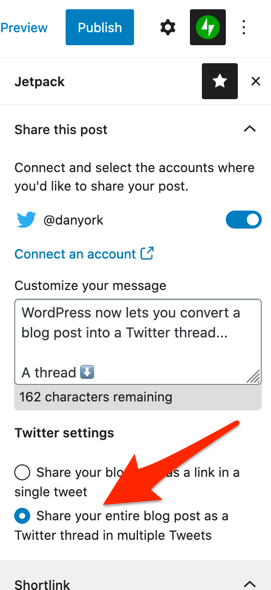Just a guy in Vermont trying to connect all the dots...
Author's posts
Nov 10
Internet Society Seeks Nominations for 2021 Board of Trustees (Featured Blog)
Oct 13
Testing Automatically Creating a Twitter Thread from a WordPress post
By way of a mention on Techmeme today, I learned that WordPress now allows you to tweet out a blog post as a linked thread of tweets. You can do this either using the hosted WordPress.com solution – or using self-hosted WordPress with the Jetpack plugin.
The Jetpack plugin included this feature as part of the 9.0 release on October 6, 2020.
All you need to do to use it is to:
- Connect a Twitter account via Jetpack.
- Press the Jetpack icon in the upper right.
- Write your blog post
You can see the setting you need to choose in this screenshot:

In theory, I’m supposed to be seeing little marks in the WordPress editor showing me where each tweet would end. I see a Twitter symbol, but it seems to move with me, and I know I have already written way more than can be in a single tweet.

(I see now that when I go back and click through the text, the Twitter symbols do show me where each Tweet will begin and end.)
My initial thought was sort of … why would I want to use this? Typically the writing I do for a blog post is very different – and often much longer – than I want for social media.
I like to write longer posts on my blogs, and then link to them from Twitter. It just seems like apples and oranges – two very different types of content.
However, as I’ve thought more about it, there is one use case I could see for this. Sometimes I know in advance that I want to create a thread on Twitter.
If I just go and create the thread on Twitter, there are a couple of issues:
- I usually want to create the thread in another editor first, so that I have my thread all figured out. (Not always… sometimes a thread just happens very organically, but sometimes I do want to write it all before tweeting.)
- The text is locked inside of Twitter’s “walled garden” of content. Yes, I can refer people to it… but it’s locked inside of Twitter. If they decide to remove my tweets, or remove my access to my account, I could lose the content.
Writing a post inside of WordPress allows me to solve both of these issues. I can easily write out text in advance, and, regardless of whatever Twitter may or may not do with my content, I have a copy on my own website.
What do you think? Will you use this new WordPress feature to create Twitter threads? (Or is this just something that will clog up Twitter timelines?)
UPDATE #1: As advertised, Jetpack very nicely created a thread on Twitter. It also added a final tweet that points over to this blog post where you can read the whole thread:

This obviously removes the need to use one of the various services that gather all the tweets in a thread so that you can read them on a single page (and share the link to that single page). Very nicely done.
Sep 24
Using the details element via a Gutenberg block
As I wrote about last year, the HTML5 “details” element is a very useful and lightweight way to create a collapsed list of questions or other content. Investigating possible options, these kind of parts of a web page seem to be often called an “accordion”. There are a number of accordion plugins, but almost all the ones I could find use some kind of additional JavaScript scripts to make the accordion.
Why do I want to use the <details> element vs JavaScript?
Because the native HTML element is already known to browsers. The extra JavaScript is not needed.
Should this be faster?
I would expect so, because there is no need to load additional JavaScript
What WordPress plugin provides this capability?
I found the “Lightweight Accordion” plugin found in the WordPress plugin directory.
Now, obviously I would need to style it a bit more to have it fit in here well, but it’s very easy to add in Gutenberg. It also has the ability to be added in the Classic Editor, too.
Sep 06
TDYR 398 – COVID-19, online learning, and… the END OF SNOW DAYS??
Sep 04
TDYR 397 – COVID-19: Have we depleted our brain’s surge capacity?
Aug 25
Call for Participation – ICANN 69 DNSSEC and Security Workshop, October 2020 (Featured Blog)
Aug 25

